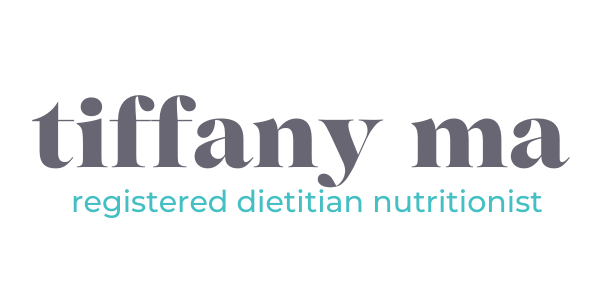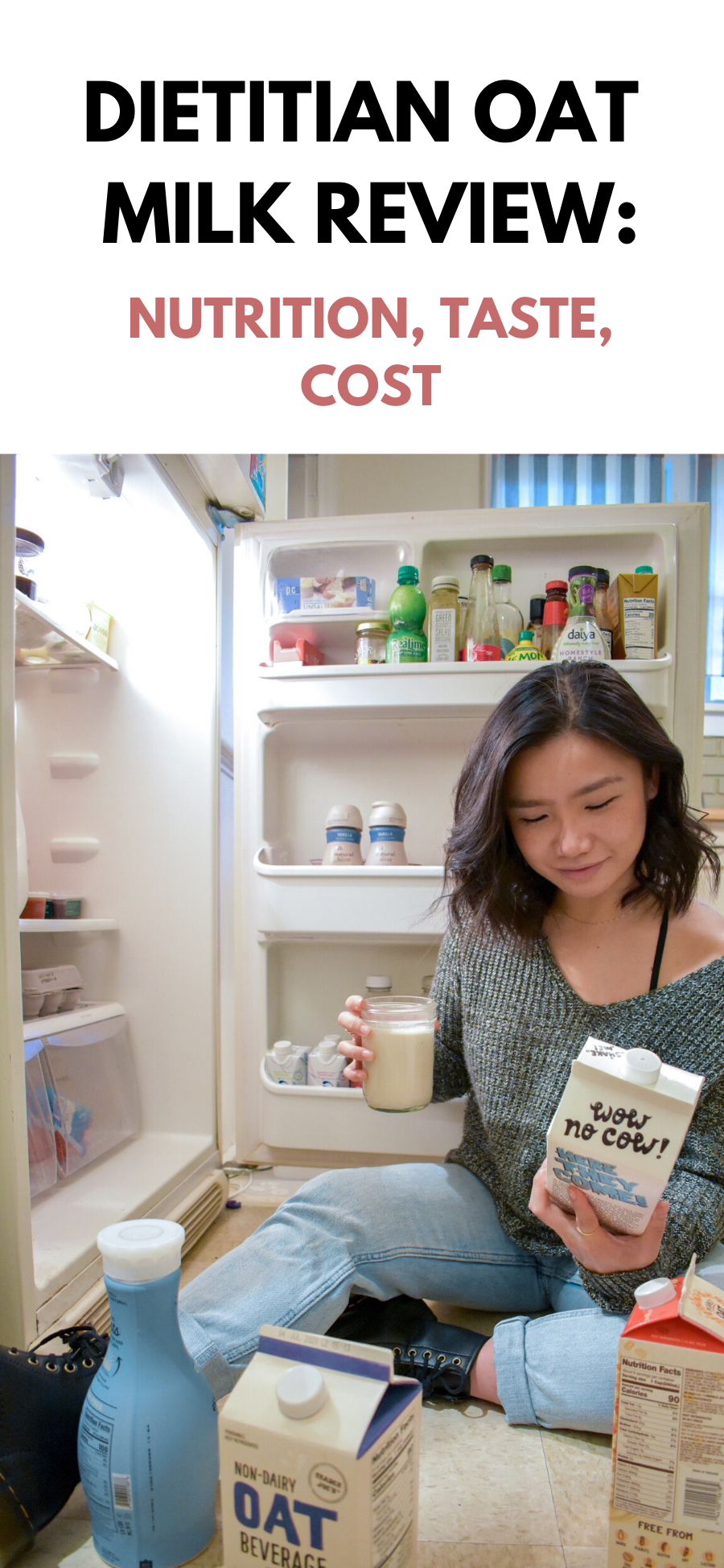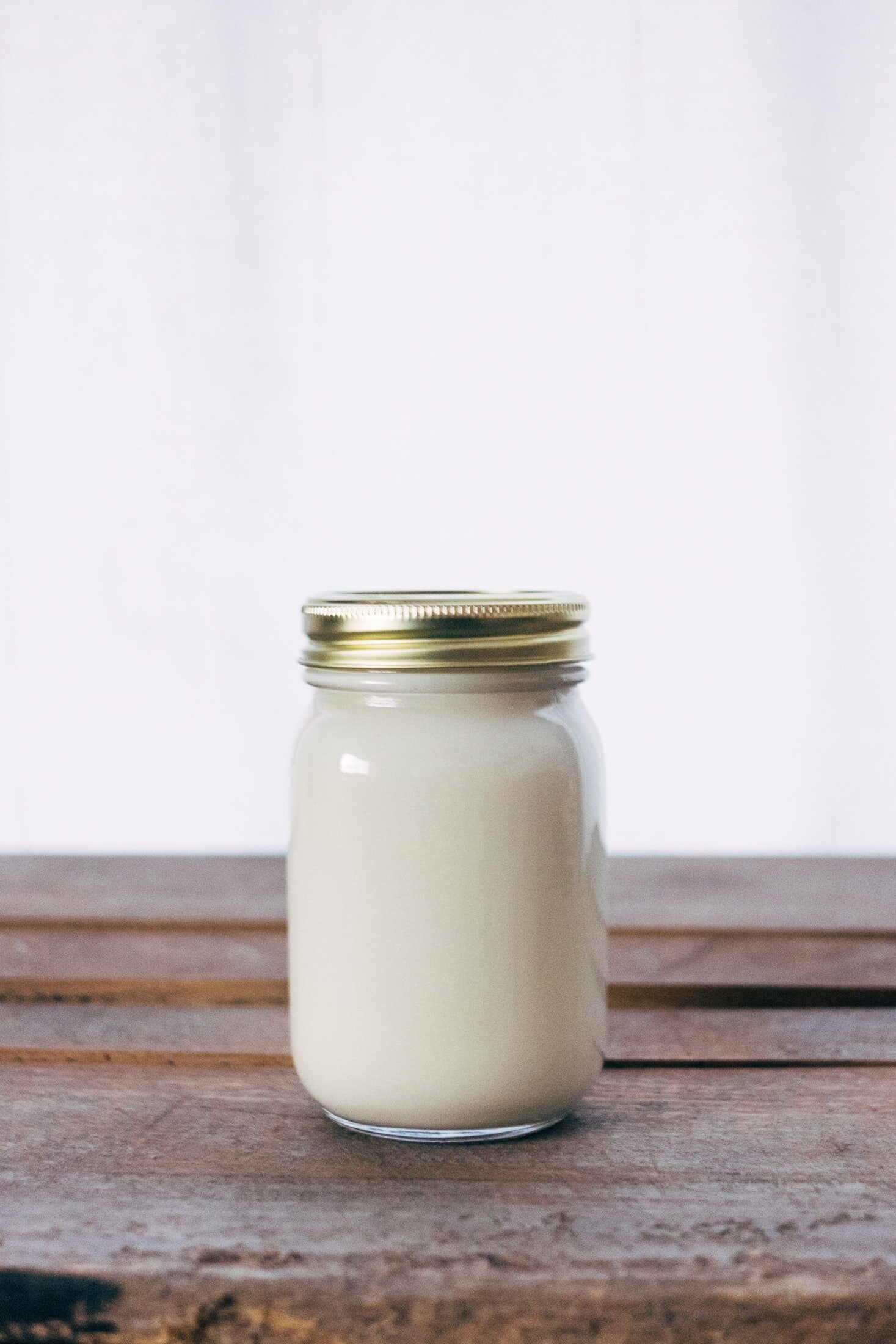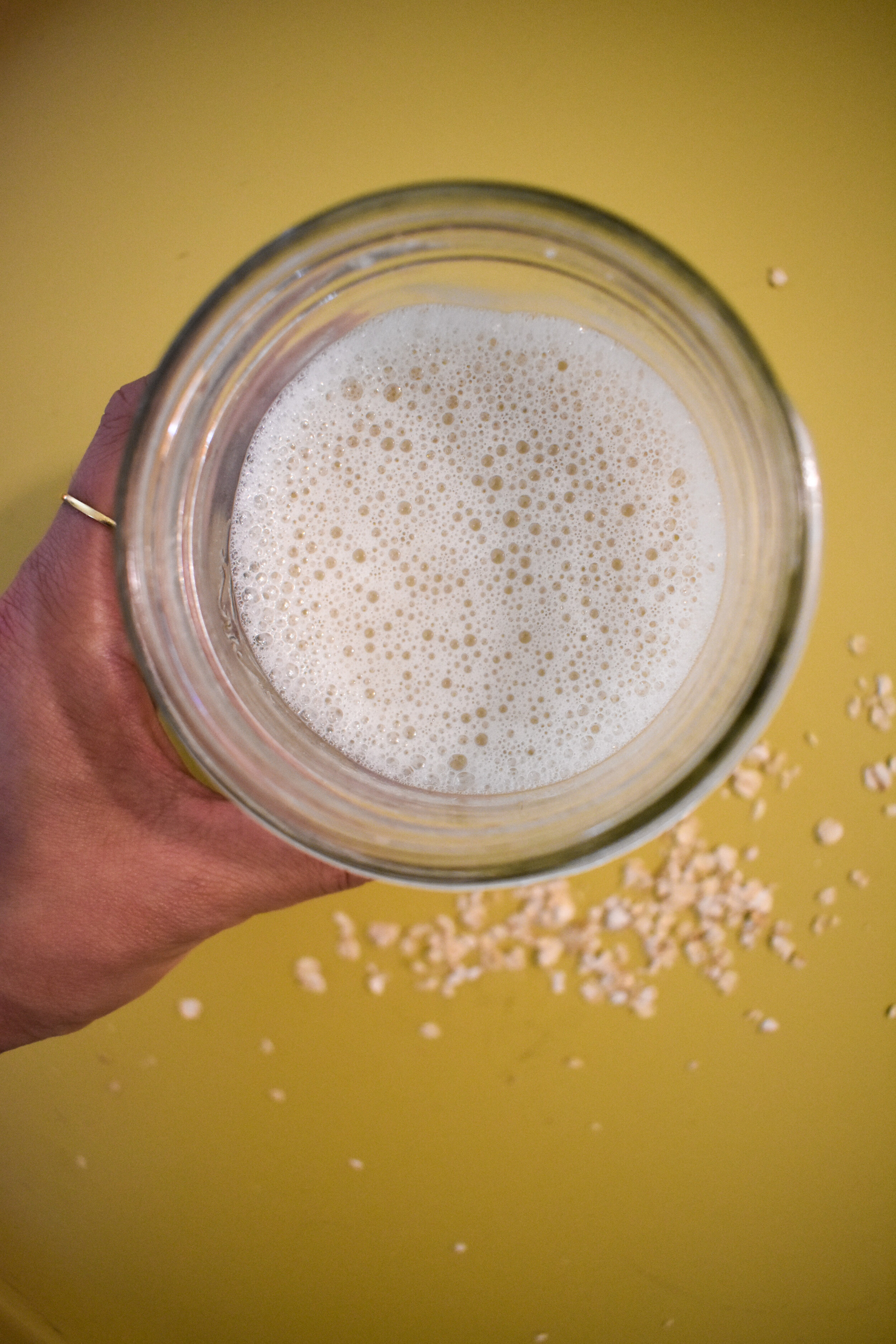A Dietitian’s Unbiased Review on Five Different Oat Milks Based on Nutrition, Taste and Cost.
Oat milks are finally here to stay. Almost every major supermarket carries at least one brand of the tasty, plant-based beverage. However, with the growing amount of products in the market, the current economic state, and an ongoing concern for our health, how do we choose the best one that meets our needs?
A Dietitian tells all.
Disclaimer: All of the products discussed below were purchased with my own money and resources. I am in no way affiliated with any of the companies mentioned.
Table of Contents
Ever since I completely stopped consuming all dairy a few months ago, I’ve been on the search for the best non-dairy milk, more specifically oat milk on the market.
Non-dairy milk is truly making a name for themselves, as the list of companies producing plant-based alternatives continue to expand. Although today’s post will be mainly talking about oat milk, I want to first highlight the number of available alternatives to cow’s milk, which include:
Nut milk
Almond milk
Hazelnut milk
Macadamia milk
Cashew milk
Flax milk
Soy milk
Coconut milk
Hemp milk
Rice milk
Pea milk
Quinoa milk
As you can see, the amount of plant-based alternatives to cow’s milk is quite impressive, huh!? I didn’t even know this list would be that long!
It does not surprise me to see food companies hopping on the plant-based train. Here are five reasons why non-dairy milks are becoming so popular:
1. Being Lactose Intolerant
When you drink or consume food, your body immediately wants to begin the process to digest it so it can be broken down into smaller parts, and then metabolized, to be delivered to the proper cells in the body.
Dairy products contain a milk-specific sugar, called lactose, which is a disaccharide that must be broken down into simple sugars— glucose, and galactose. The enzyme responsible for this digestion process is called lactase. If lactase is insufficient, lactose will remain undigested, causing varying gastrointestinal distress (bloating, abdominal pain, diarrhea, gas, and even in some individuals—vomiting… yikes!).
Being deficient in the lactase enzyme can be due to many factors; with one of the largest contributing factors decided well before we are even born! White North Europeans are the least likely to be intolerant, with some Asian populations even being 100% lactose intolerant.
2. Adopting a Plant-Based Diet
Gallup, in American analytics and advisory company, surveyed Americans and found the percentage of individuals adopting vegan diets increased from 2 to 3% in the total population back in 2018. Although this may just be 1%, this still equates to about ~3.2 million people in the US alone! Back in 2015, this percentage was as low as 0.4%.
In other parts of the world, this number is even higher. For example, in 2015, 1 - 2 % of British adults and 5 - 10% of German adults were reported to follow a plant-based diet.
As the amount of individuals interested in adopting plant-based diets arise, the increased demand for vegan products and services follow suit. In fact, the vegan food industry is expected to reach $31.4 billion by 2026. Back in 2018, the vegan food market was just valued at $14.2 billion!
3. Having a Dairy Allergy or a Dairy Sensitivity
A dairy allergy… isn’t that the same as being lactose intolerant? No, actually! Having an allergy specifically means your body undergoes an inflammatory response as a reaction to an external substance. Food allergies are caused by an IgE-mediated reaction to a food substance.
If you are allergic to dairy, upon consuming it, your body will stimulate lymphocytes to produce and release IgE antibodies. These antibodies will then circulate through the blood and attach to the surface of some cells.
Do you ever wonder why some people tend to experience redness and flushing of the skin if they eat something they’re allergic to?
It’s because these antibodies tend to attach to the surface of cells called mast cells. Mast cells store chemicals, such as histamine. Histamine is then released, causing adverse symptoms in the tissues (such as the nose, throat, lungs, skin, and gastrointestinal tract).
A sensitivity is similar to having an allergic reaction, but just a bit less severe. Sensitivities to food allergies are a bit difficult to diagnose because in many cases, they are dosage-dependent.
4. Being Calorie Conscious
For those who are conscious of their calorie intake, non-dairy milk proves to be a good alternative to cow’s milk.
Some non-dairy milks are almost even half the calories of cow’s milk.
5. Prevalence of High Cholesterol
All animal and dairy products contain saturated fat in them. Studies show that a diet high in saturated fat is linked to negative health outcomes, more specifically, in regards to heart health.
Randomized-controlled trials have been conducted as early as the late 1990s testing the health outcomes of oat milk vs cow’s milk consumption, and a lot of the research is quite promising.
In this randomized, controlled-double blind design, 66 men were randomly assigned to two groups; one group was asked to drink oat milk, and the other a controlled non-dairy milk (rice milk). Compared with rice milk, the intake of oat milk proved a significantly lower serum total cholesterol and LDL cholesterol.
In another study, consumption of oat milk was proven to reduce total and LDL cholesterol (the bad kind) levels of adults with high cholesterol without impacting the HDL cholesterol (the good kind). The study made note that the beta-glucan components in oats seemed to play a significant role in the overall outcomes, primarily, because beta-glucan is a soluble fiber, and we understand that soluble fibers have a cholesterol-reducing effect.
What is Oat Milk and How is Oat Milk Made?
It is exactly what it sounds like—milk made from oats.
Oats in their natural form requires processing due to its indigestible outer shell. Making oat milk from an industrial standpoint often follows these steps:
Milling breaks apart the outer hulls of the grain.
Enzyming will further break down the oat starches into smaller components. Enzymes are also added to create a thick liquid base.
The bran is then separated from the oats, leaving behind loose fibers.
If applicable, other flavorings and ingredients are added, such as fortification of vitamins, minerals, sweeteners, and oils.
Unfortified oat milk is lower in calcium, iron, and vitamin A than dairy milk.
Fortification usually includes the following: vitamin D, vitamin A, vitamin b12, riboflavin, and calcium.
The oat milk is then sterilized before homogenized.
Lastly, oat milk will undergo heat treatment to extend shelf life.
Are there Nutritional Benefits of Oat Milk?
Oat milk makes a compelling story for its role in reducing cholesterol because of its soluble fiber component. If you have high cholesterol, or may be at risk for developing heart-related diseases, making the switch to oat milk from dairy milk may certainly help.
It’s important to note that it is hard to evaluate oat milk as a whole due to the abundance of varieties and brands on the shelves.
However, since the majority of oat milks on the market are fortified, they do provide us with some important micronutrients.
With that being said, fortified oat milk can be a great substitute for those with a dairy, soy, nut or gluten allergy.
Note: Although oats are naturally gluten-free, some facilities that produce oat milk may process wheat products.
Jump to this part of the post to see which ONE of the FIVE products I reviewed are FDA Certified Gluten - Free.
Oat Milk vs Cow’s Milk
Many non-dairy milks are not busting their backs trying to emulate the nutritional profile that milk has, nor should consumers have these expectations in the first place.
Yes. Indeed, non-dairy milk may never achieve the protein content of cow’s milk (aka it’s also time we stop fussing about the protein content of all non-dairy products).
For some companies, like Oatly, having a positive environmental impact is at the forefront of their philosophy, and has been since their beginnings in the late 1990s.
Oat Milk Review: Nutritional Value, Overall Taste, and Cost
Oat milk is known for its much creamier consistency compared to other non-dairy milk, which is also why it caught so much traction as soon as it hit the shelves.
However, as I mentioned earlier, not all oat milk is created the same, which means they ultimately have different nutritional benefits, and taste!
In this review, I test FIVE different oat milks and rank them according to nutritional value, overall taste, and cost.
Nutritional Value:
As stated earlier, we understand that soluble fiber, more specifically, the soluble fiber from the beta-glucans of oats have an LDL-reducing effect.
The majority of oat milks in the market are fortified with nutrients ranging from Vitamin A to even B12, making it pretty sweet for us plant-based folks out here. However, fortification varies in all varieties, and stark differences even exist in the five oat milk brands I tested!
Do you ever pay attention to the daily values on a nutrition label? They’re usually far off to the right of a label and in percentages. Although these numbers may seem foreign to you, they do serve a purpose.
The percentage tells us how much of that specific nutrient the food item will be able to provide us with in order to meet the daily recommendation (in one serving).
These percentages will then determine whether or not:
A food item is a good source of nutrients: 10 - 19% of the Daily Value (DV)
A food item is an excellent source of nutrients: At least 20% of the Daily Value (DV)
The Most Nutritious Oat Milk: The Original Oatly
My pick for the most nutritious oat milk:
Oatly takes the cake on this one. The majority of the vitamins fortified in a glass of Oatly are considered to be an excellent source! Here are the six micronutrients that pack a punch with Oatly:
Vitamin D: 20%
Vitamin A: 20%
Calcium: 25%
Vitamin B12: 50%
Riboflavin: 45%
Phosphorous: 20%
Who’s impressed? I know I am! A food product with an excellent source of Vitamin A, and D is fantastic, as these are nutrients that majority of Americans struggle to meet, let alone, plant-based folks.
My pick for the least nutritious oat milk:
Califia Farms ranked the lowest here. The two vitamins that are fortified in one serving include only Calcium and Vitamin E. Califia missed the mark since all the other oat milks are fortified with some amount of B12.
Items with B12 fortification are important for long-term vegans, as the majority of B12 comes from animal-based sources such as eggs and red meat.
Summary of Rankings:
Oatly: Packed to the brim with six total micronutrients that are considered excellent sources.
Silk: Has a total of four micronutrients that are excellent sources AND provides a whopping 100% of the Daily Value for Vitamin B12.
Trader Joe's: Fortified with four micronutrients that exceed the highest DV for Vitamin A and Riboflavin.
Planet Oat: Five micronutrients that are fortified enough to be excellent sources, but are on the lower end.
Califia Farms: Fortification of calcium and Vitamin E (which explains their high fat content), but lacking Vitamin B12 fortification.
Overall Taste:
I did a double-blind taste test on all five oat milks to limit my bias as much as I possibly could. I also sipped water in between tastings to cleanse my palate.
Yes, I do take this stuff very seriously.
Overall taste was based off of general creaminess and texture. One major observation I made was that each oat milk truly did taste differently from one another.
The Tastiest Oat Milk: Trader Joe’s Non-Dairy Oat Beverage
My pick for the tastiest oat milk:
Trader Joe’s Non-Dairy Oat Beverage was a clear winner in this one. Their oat milk was the creamiest, and overall tastiest. There was a really pleasant oat taste, and there was no grittiness whatsoever.
My pick for the least tastiest oat milk:
Califia Farms ranked low on this one as well. There was a distinct odd after-taste that just didn’t sit well. There also seemed to be a bit of a textural component even though I made sure to shake the oat milk well.
Summary of Rankings:
Trader Joe’s: The creamiest and best texture-wise. The milk also nailed the visual consistency by having the most “milk” look to it.
Oatly: Right behind Trader Joe’s, although just a teeny tiny less creamy. No issues with texture.
Silk: Very similar to Oatly. Texture was great.
Planet Oat: Fell short under creaminess. Nothing really stood out to me. Certainly didn’t taste bad.
Califia Farms: There is an astringent and odd after-taste that is not enjoyable. The milk was a bit watery actually.
Cost:
When oat milk hit the shelves a few years ago, many refrained from including it in their weekly grocery trip due to its high price. Nowadays, oat milk is becoming a common household staple, which has increased the demand, ultimately decreasing the cost! Whoo!
Here are the prices per serving (8 oz/240 mL) for the five brands I tested (from the least expensive to the most expensive).
Cost per Serving (8 oz /240 mL):
Trader Joe’s: $0.50/serving
Silk: $0.50/serving
Planet Oat: $0.56/serving
Oatly: $0.58/serving
Califia Farms: $0.66/serving
The Best Bang for Your Buck: Silk Oat Yeah
When it comes to saving bucks, I’m all for it. For this reason, Silk’s Oat Yeah truly impressed me.
Their oat milk provides an impressive 100% of the daily value for B12, which is a micronutrient long-term vegans should be paying attention to.
Considering that their oat milk ranked #3, next to Trader Joe’s Non-Dairy Oat Beverage and Oatly on taste, AND is one of the least expensive oat milks out there, makes this a no brainer.
Other Considerations:
Although my goal in creating this post was to provide you my opinions about the nutritional value, taste, and cost of the current oat milks on the market, there is still a bit of ground I did not cover.
Each of the companies mentioned in this review have their own set of “bragging rights” when it comes to their milk. These bragging rights range from how they process their milks, to the ingredients they pride themselves on not using (which is a whole other subject in itself).
Califia Farms:
Saves water and protects soil with low-to-no irrigation and tilling
BPA free
Carrageenan free
No use of gums
5 g of omega-9-fatty acids (explains the high fat content at 7g/serving).
Least amount of added sugars (2g/serving)
Silk Oat Yeah:
“Drop for Drop” - putting back the water into the environment that is used to grow the oats
Free from: dairy, nuts, soy, carrageenan, cholesterol, artificial colors and flavor
Trader Joe’s:
Breaks down the starches in the oats to create sugar instead of using cane sugar
Oatly:
The first company to ever make oat milk (30+ years).
Certified Vegan Label
Non-GMO Verified
Most protein per serving (3g/serving)
Planet Oat:
Free from: dairy, peanuts, gluten, soy, lactose, tree nuts, artificial flavors, colors and preservatives
Final Verdict: The Best Oat Milk on the Market
We all have different wants and needs. Our nutrition and health are no exceptions to this concept.
Ideally, the decisions you make about what you eat should encompass as many of your values, wants, and needs, while still considering your health.
For this reason, Silk Oat Yeah is the winner for me.
Silk’s Oat Yeah:
✔️Has the certified vegan label; meaning animals were not involved in the making of this product, whatsoever.
✔️Is one of the least expensive oat milks in the market.
✔️Has a pretty impressive micronutrient profile.
✔️Still really tasty.
Silk’s Oat Yeah also has FOUR different variations of oat milk, including: plain, vanilla, chocolate, and sugar-free.
If you’re just looking for a tasty oat milk, make a dash to Trader Joe’s.
If you’re looking to save some bucks, try out Silk Oat Yeah.
If you’re all about squeezing every millimicrogram of micronutrient from the foods you eat, then stock up on Oatly.
Life is complicated enough as is, it’s a good thing oat milk is not.
Do you like oat milk? If so, do you have a favorite?! Tell me in the comments below!
















